Optimizing Energy Consumption in the Home Energy Management System via a Bio-Inspired Dragonfly Algorithm and the Genetic Algorithm
Abstract
1. Introduction
2. Literature Review
3. Proposed System Model
3.1. Classification of Load
3.1.1. Shiftable Appliances
3.1.2. Non-Shiftable Appliances
4. Pricing Signal
5. Proposed Dragonfly Algorithm
- Separation represents the static collision prevention of dragonflies in the swarm from other dragonflies of the nearby vicinity.
- The alignment shows the velocity matching of one dragonfly in the swarm to the other individual dragonfly in the same swarm of dragonflies.
- Cohesion represents the struggle of dragonflies toward the center of the mass of the nearby individual dragonflies.
| Algorithm 1: Pseudocode of the proposed Dragonfly Algorithm |
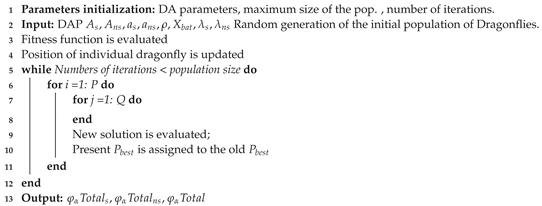 |
6. Results and Discussion
6.1. Daily Basis Hourly Load
6.2. Daily Basis Hourly Cost
6.3. Total Average Cost
6.4. Daily-Basis 30 Days Load Pattern
6.5. PAR
6.6. Average Waiting Time
7. Comparison and Limitations
7.1. Comparison
7.2. Limitations
8. Conclusions
Author Contributions
Funding
Acknowledgments
Conflicts of Interest
Abbreviations
| ABC | Artificial bee colony |
| ANN | Artificial neural network |
| BFA | Bacterial foraging algorithm |
| BPSO | Binary particle swarm optimization |
| CSA | Cuckoo search algorithm |
| DA | Dragonfly algorithm |
| DG | Distributed generation |
| DR | Demand response |
| DSM | Demand side management |
| EDE | Enhanced differential evolution |
| ED | Economic dispatch |
| EDTLA | Enhanced differential teaching learning algorithm |
| EWA | Earthworm algorithm |
| EMC | Energy management controller |
| GA | Genetic algorithm |
| GWO | Grey wolf optimization |
| HSA | Harmony search algorithm |
| LOT | Length of operational time |
| MIP | Mixed integer programming |
| MVPA | Most valuable player algorithm |
| OTI | Operational time interval |
| PAR | Peak-to-average power ratio |
| PEV | Plug-in electric vehicle |
| PSO | Particle swarm optimization |
| PV | Photo-voltaic |
| RES | Renewable energy sources |
| RTP | Real-time pricing |
| SG | Smart grid |
| SH | Smart home |
| SM | Smart meter |
| TG | Traditional grid |
| TLGO | Teacher learning genetic optimization |
| WDO | Wind-driven optimization |
| TLBO | Teaching learning-based optimization |
References
- Hussain, I.; Aamir; Ullah, I.; Khan, N.; Riaz, M. Reliable and Secure Advanced Metering Infrastructure for Smart Grid Network. In Proceedings of the 2018 International Conference on Computing, Electronic and Electrical Engineering (ICE Cube), Quetta, Pakistan, 12–13 November 2018; pp. 1–6. [Google Scholar] [CrossRef]
- Strbac, G. Demand side management: Benefits and challenges. Energy Policy 2008, 36, 4419–4426. [Google Scholar] [CrossRef]
- Yang, J.; Zhang, G.; Ma, K. Matching supply with demand: A power control and real time pricing approach. Int. J. Electr. Power Energy Syst. 2014, 61, 111–117. [Google Scholar] [CrossRef]
- Hu, W.; Chen, Z.; Bak-Jensen, B. Optimal operation strategy of battery energy storage system to real-time electricity price in Denmark. In Proceedings of the IEEE PES General Meeting, Providence, RI, USA, 25–29 July 2010; pp. 1–7. [Google Scholar]
- Tascikaraoglu, A.; Boynuegri, A.R.; Uzunoglu, M. A demand side management strategy based on forecasting of residential renewable sources: A smart home system in Turkey. Energy Build. 2014, 80, 309–320. [Google Scholar] [CrossRef]
- Logenthiran, T.; Srinivasan, D.; Shun, T.Z. Demand side management in smart grid using heuristic optimization. IEEE Trans. Smart Grid 2012, 3, 1244–1252. [Google Scholar] [CrossRef]
- Khan, I.; Singh, D. Energy-balance node-selection algorithm for heterogeneous wireless sensor networks. ETRI J. 2018, 40, 604–612. [Google Scholar] [CrossRef]
- Mirjalili, S. Dragonfly algorithm: A new meta-heuristic optimization technique for solving single-objective, discrete, and multi-objective problems. Neural Comput. Appl. 2016, 27, 1053–1073. [Google Scholar] [CrossRef]
- Lu, R.; Hong, S.H.; Yu, M. Demand Response for Home Energy Management Using Reinforcement Learning and Artificial Neural Network. IEEE Trans. Smart Grid 2019, 10, 6629–6639. [Google Scholar] [CrossRef]
- Javaid, N.; Hussain, S.M.; Ullah, I.; Noor, M.A.; Abdul, W.; Almogren, A.; Alamri, A. Demand Side Management in Nearly Zero Energy Buildings Using Heuristic Optimizations. Energies 2017, 10, 1131. [Google Scholar] [CrossRef]
- Khan, Z.A.; Zafar, A.; Javaid, S. Hybrid meta-heuristic optimization based home energy management system in smart grid. J. Ambient. Intell. Hum. Comput. 2019, 10, 4837–4853. [Google Scholar] [CrossRef]
- Wu, X.; Hu, X.; Yin, X.; Moura, S.J. Stochastic Optimal Energy Management of Smart Home With PEV Energy Storage. IEEE Trans. Smart Grid 2018, 9, 2065–2075. [Google Scholar] [CrossRef]
- Ullah, I.; Hussain, S. Time-Constrained Nature-Inspired Optimization Algorithms for an Efficient Energy Management System in Smart Homes and Buildings. Appl. Sci. 2019, 9, 792. [Google Scholar] [CrossRef]
- Ou, T.; Hong, C. Dynamic operation and control of microgrid hybrid power systems. Energy 2014, 66, 314–323. [Google Scholar] [CrossRef]
- Hussain, H.M.; Javaid, N.; Iqbal, S.; Hasan, Q.U.; Aurangzeb, K.; Alhussein, M. An Efficient Demand Side Management System with a New Optimized Home Energy Management Controller in Smart Grid. Energies 2018, 11, 190. [Google Scholar] [CrossRef]
- Manzoor, A.; Javaid, N.; Ullah, I.; Abdul, W.; Almogren, A.; Alamri, A. An Intelligent Hybrid Heuristic Scheme for Smart Metering based Demand Side Management in Smart Homes. Energies 2017, 10, 1258. [Google Scholar] [CrossRef]
- Ullah, I.; Hussain, I.; Singh, M. Exploiting Grasshopper and Cuckoo Search Bio-Inspired Optimization Algorithms for Industrial Energy Management System: Smart Industries. Electronics 2020, 9, 105. [Google Scholar] [CrossRef]
- Singh, D. Mobility and Energy Efficient Mechanism for Low power devices to Support Global Healthcare System. J. Theor. Appl. Inf. Technol. 2014, 66, 315–329. [Google Scholar]
- Ou, T.-C.; Su, W.-F.; Liu, X.-Z.; Huang, S.-J.; Tai, T.-Y. A Modified Bird-Mating Optimization with Hill-Climbing for Connection Decisions of Transformers. Energies 2016, 9, 671. [Google Scholar] [CrossRef]
- Jamil, A.; Alghamdi, T.A.; Khan, Z.A.; Javaid, S.; Haseeb, A.; Wadud, Z.; Javaid, N. An Innovative Home Energy Management Model with Coordination among Appliances using Game Theory. Sustainability 2019, 11, 6287. [Google Scholar] [CrossRef]
- Singh, D.; Lee, H.J.; Chung, W.Y. An energy consumption technique for global healthcare monitoring applications. In Proceedings of the 2nd International Conference on Interaction Sciences: Information Technology, Culture and Human, Seoul, Korea, 24–26 November 2009; pp. 539–542. [Google Scholar]
- Ullah, I.; Khitab, Z.; Khan, M.N.; Hussain, S. An Efficient Energy Management in Office Using Bio-Inspired Energy Optimization Algorithms. Processes 2019, 7, 142. [Google Scholar] [CrossRef]
- Asgher, U.; Babar Rasheed, M.; Al-Sumaiti, A.S.; Ur-Rahman, A.; Ali, I.; Alzaidi, A.; Alamri, A. Smart Energy Optimization Using Heuristic Algorithm in Smart Grid with Integration of Solar Energy Sources. Energies 2018, 11, 3494. [Google Scholar] [CrossRef]
- Aslam, S.; Bukhsh, R.; Khalid, A.; Javaid, N.; Ullah, I.; Fatima, I.; Hasan, Q.U. An efficient home energy management scheme using cuckoo search. In Proceedings of the International Conference on P2P, Parallel, Grid, Cloud and Internet Computing, Barcelona, Spain, 8–10 November 2017; pp. 167–178. [Google Scholar]
- Tsui, K.M.; Chan, S. Demand response optimization for smart home scheduling under real-time pricing. IEEE Trans. Smart Grid 2012, 3, 1812–1821. [Google Scholar] [CrossRef]
- Ramli, M.A.; Bouchekara, H.; Alghamdi, A.S. Efficient Energy Management in a Microgrid with Intermittent Renewable Energy and Storage Sources. Sustainability 2019, 11, 3839. [Google Scholar] [CrossRef]
- Zhao, J.; Liu, S.; Zhou, M.; Guo, X.; Qi, L. Modified cuckoo search algorithm to solve economic power dispatch optimization problems. IEEE/CAA J. Autom. Sin. 2018, 5, 794–806. [Google Scholar] [CrossRef]
- Nimma, K.S.; Al-Falahi, M.D.A.; Nguyen, H.D.; Jayasinghe, S.D.G.; Mahmoud, T.S.; Negnevitsky, M. Grey Wolf Optimization-Based Optimum Energy-Management and Battery-Sizing Method for Grid-Connected Microgrids. Energies 2018, 11, 847. [Google Scholar] [CrossRef]
- Iqbal, Z.; Javaid, N.; Iqbal, S.; Aslam, S.; Khan, Z.A.; Abdul, W.; Almogren, A.; Alamri, A. A Domestic Microgrid with Optimized Home Energy Management System. Energies 2018, 11, 1002. [Google Scholar] [CrossRef]
- Al-Sakkaf, S.; Kassas, M.; Khalid, M.; Abido, M.A. An Energy Management System for Residential Autonomous DC Microgrid Using Optimized Fuzzy Logic Controller Considering Economic Dispatch. Energies 2019, 12, 1457. [Google Scholar] [CrossRef]
- Javaid, N.; Ahmed, F.; Ullah, I.; Abid, S.; Abdul, W.; Alamri, A.; Almogren, A.S. Towards Cost and Comfort Based Hybrid Optimization for Residential Load Scheduling in a Smart Grid. Energies 2017, 10, 1546. [Google Scholar] [CrossRef]
- Available online: http://www.energyonline.com/Data/GenericData.aspx?DataId=2&${ISO-NE}_{---}{Day-Ahead}_{-}{Energy}_{-}Price$ (accessed on 27 December 2019).
- Beaudrot, L.; Ahumada, J.A.; O’Brien, T.; Alvarez-Loayza, P.; Boekee, K.; Campos-Arceiz, A.; Eichberg, D. Standardized assessment of biodiversity trends in tropical forest protected areas: The end is not in sight. PLoS Biol. 2016, 14, e1002357. [Google Scholar] [CrossRef]
- Wikelski, M.; Moskowitz, D.; Adelman, J.S.; Cochran, J.; Wilcove, D.S.; May, M.L. Simple rules guide dragonfly migration. Biol. Lett. 2006, 2, 325–329. [Google Scholar] [CrossRef]
- Russell, R.W.; May, M.L.; Soltesz, K.L.; Fitzpatrick, J.W. Massive swarm migrations of dragonflies (Odonata) in eastern North America. Am. Midl. Nat. 1998, 140, 325–343. [Google Scholar] [CrossRef]

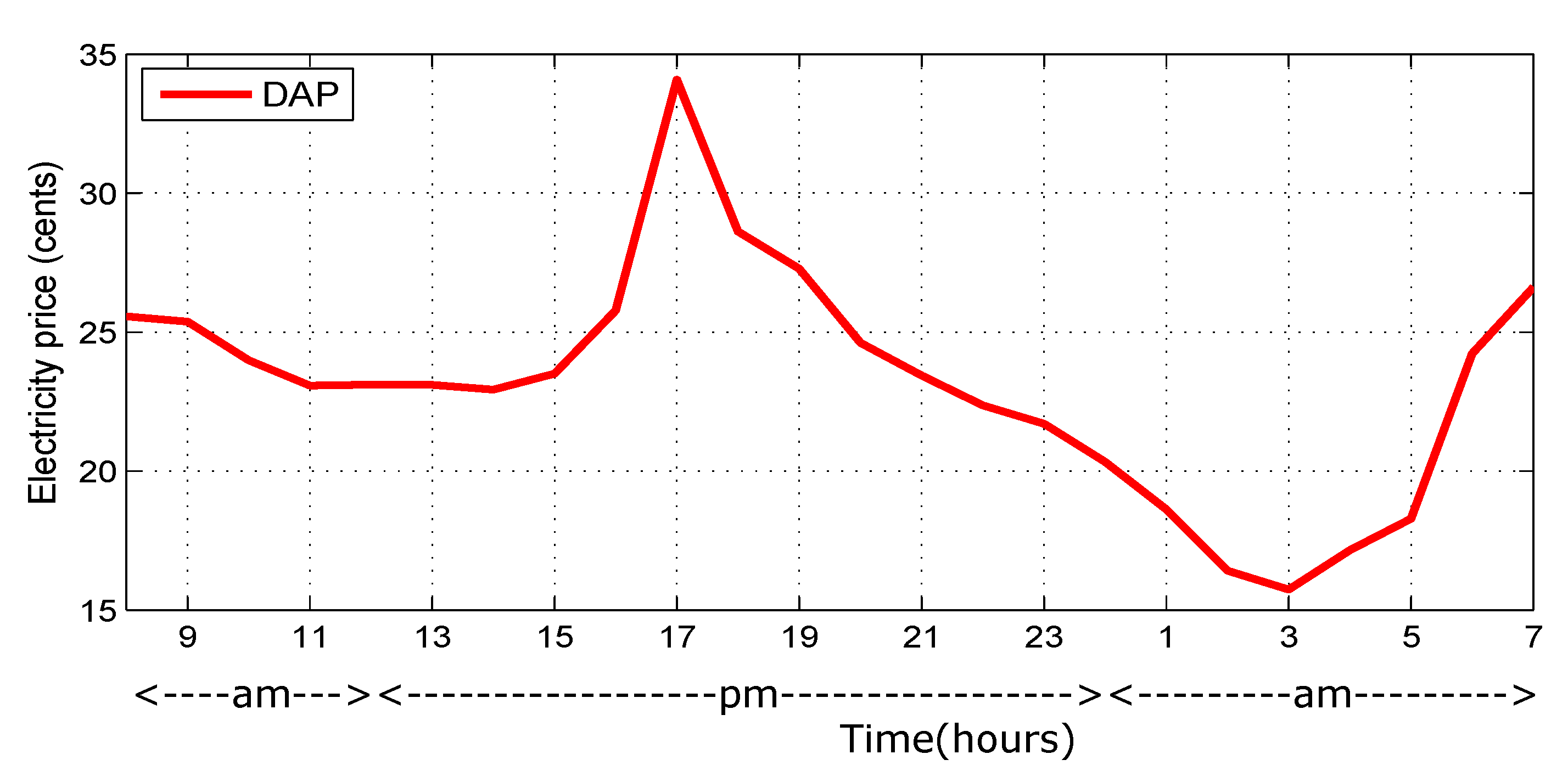
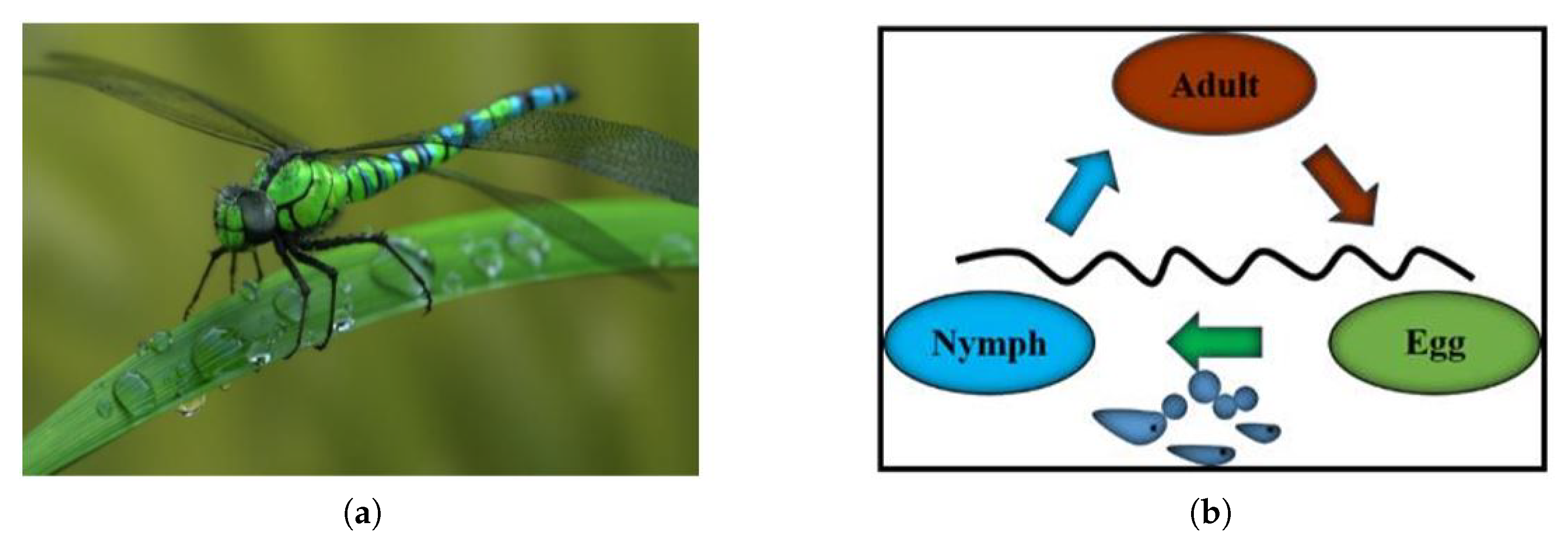
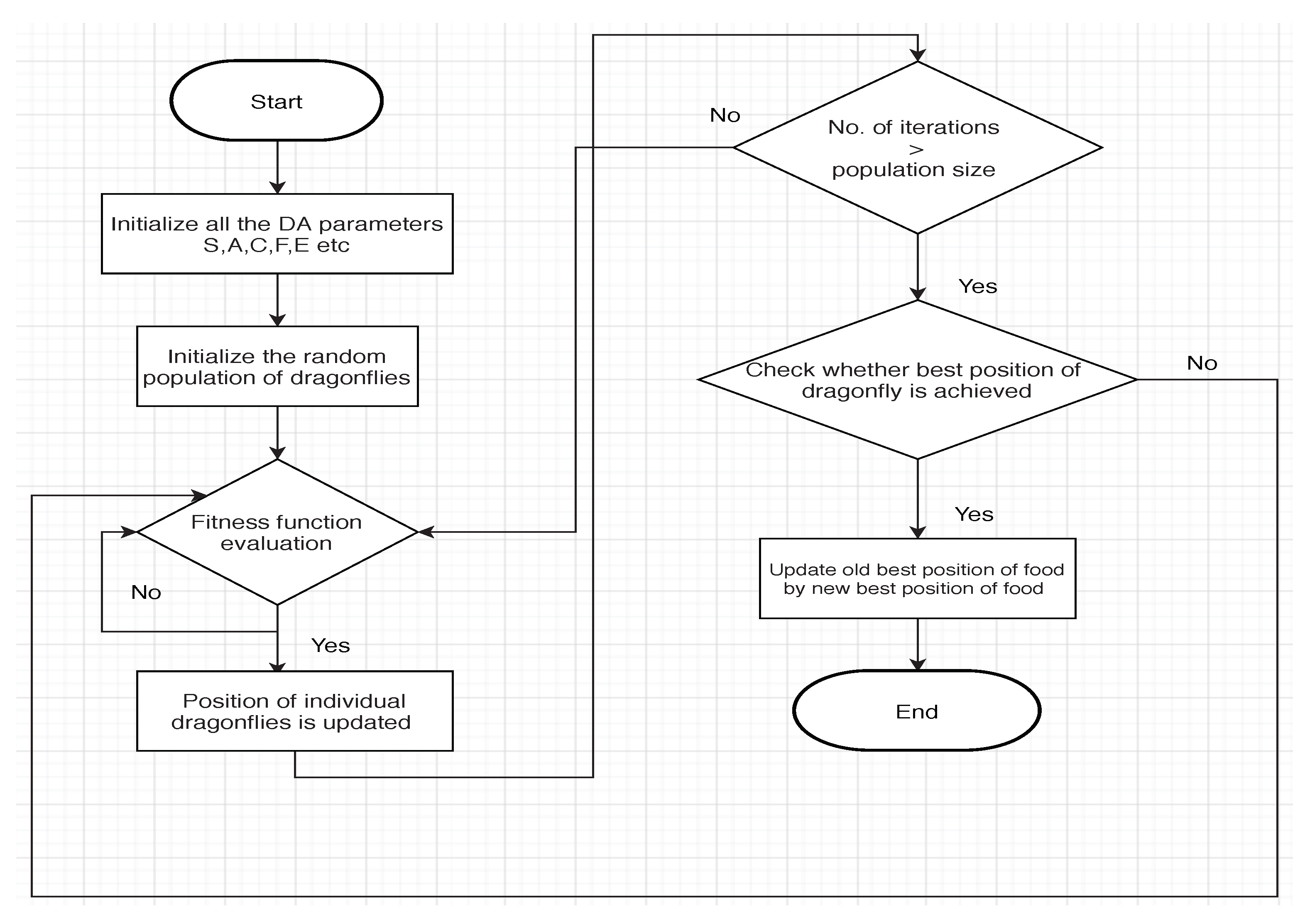
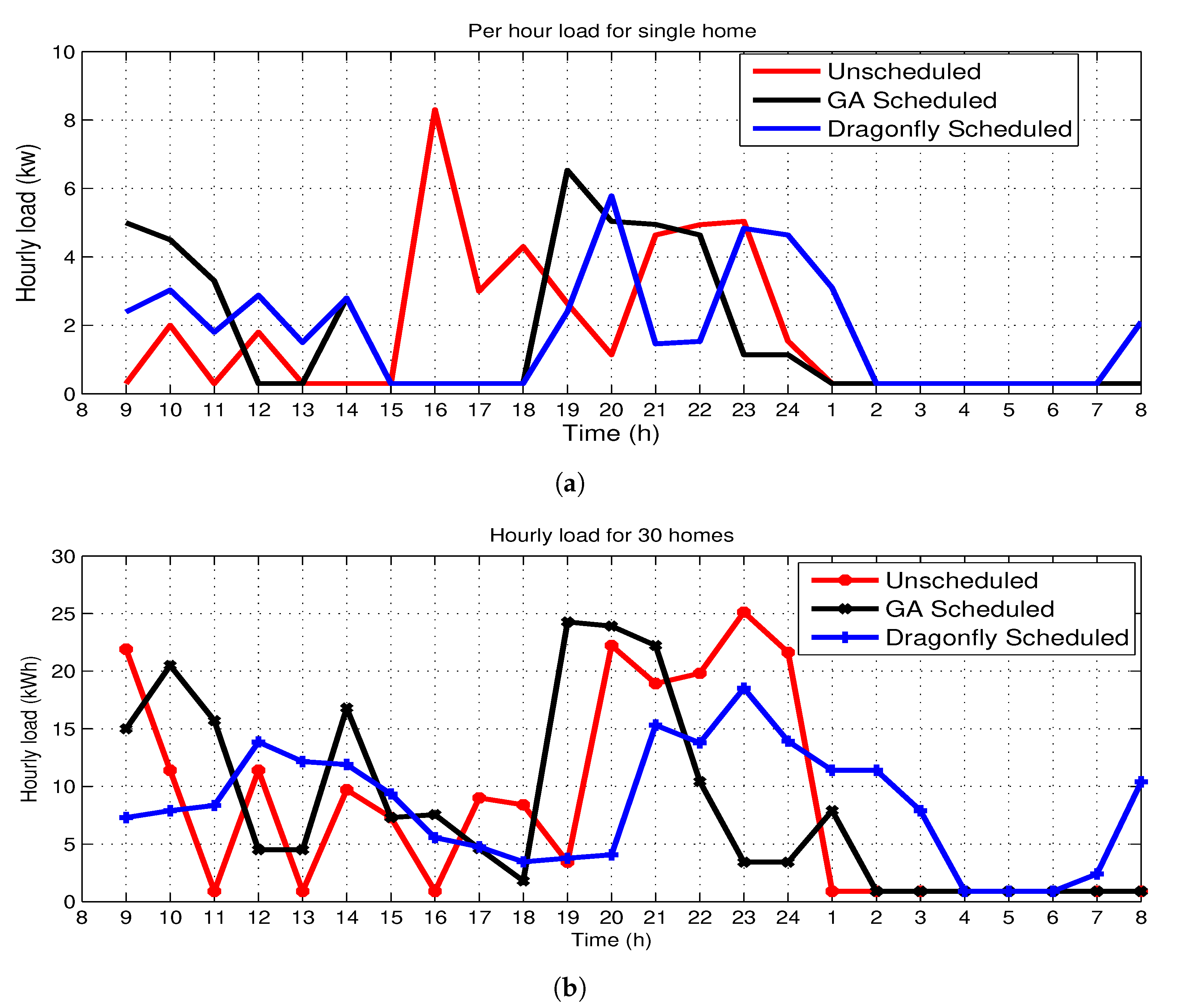
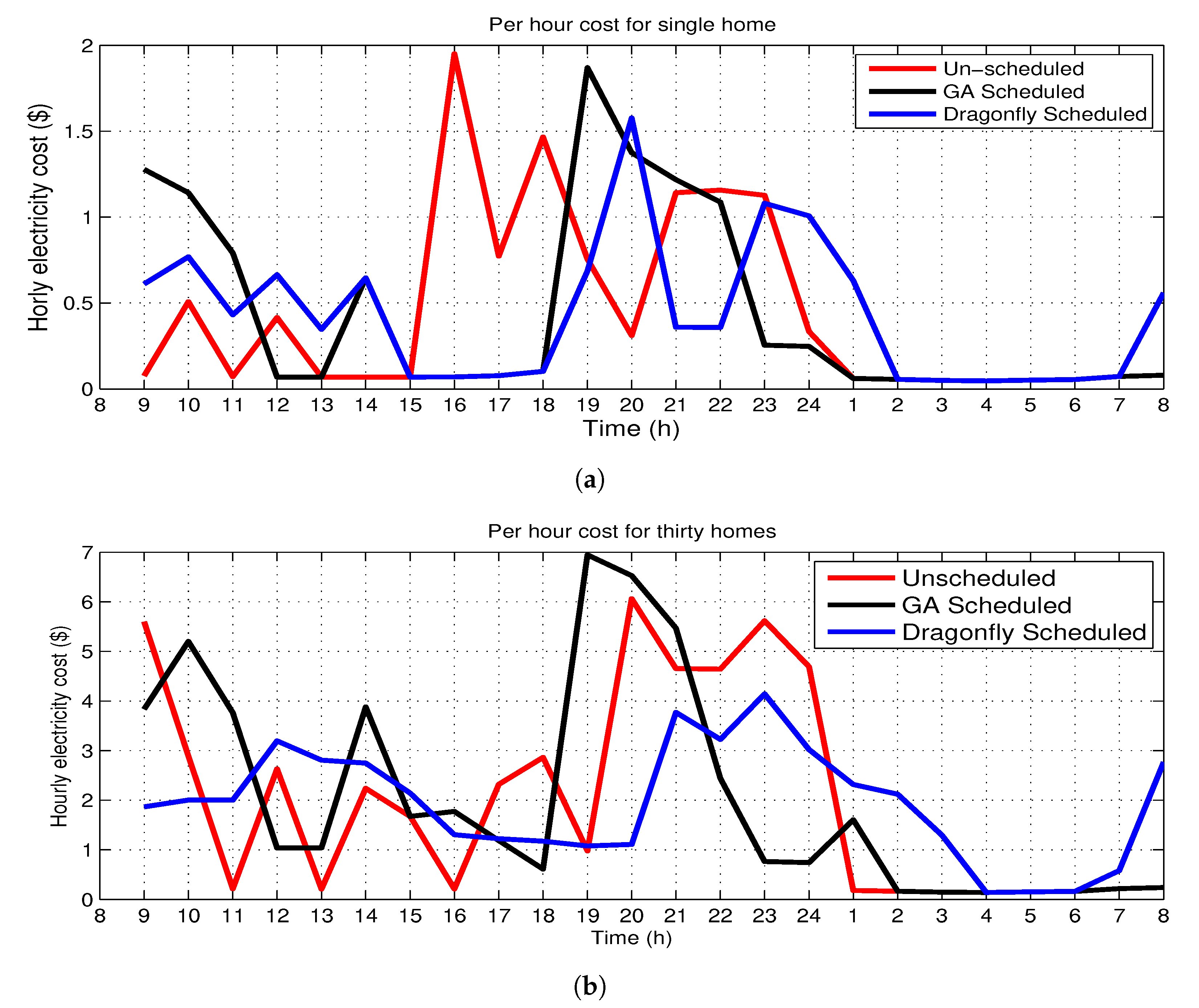
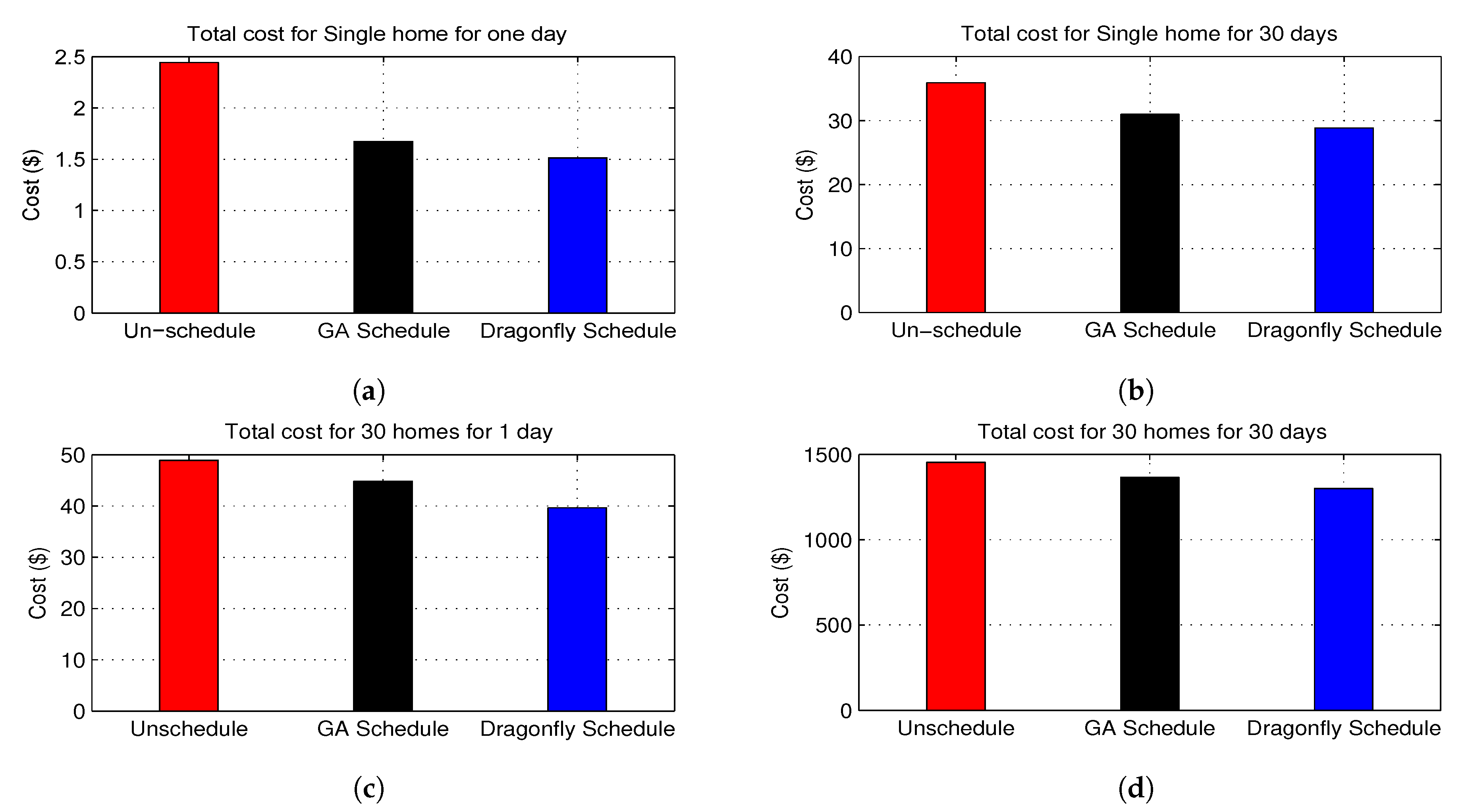
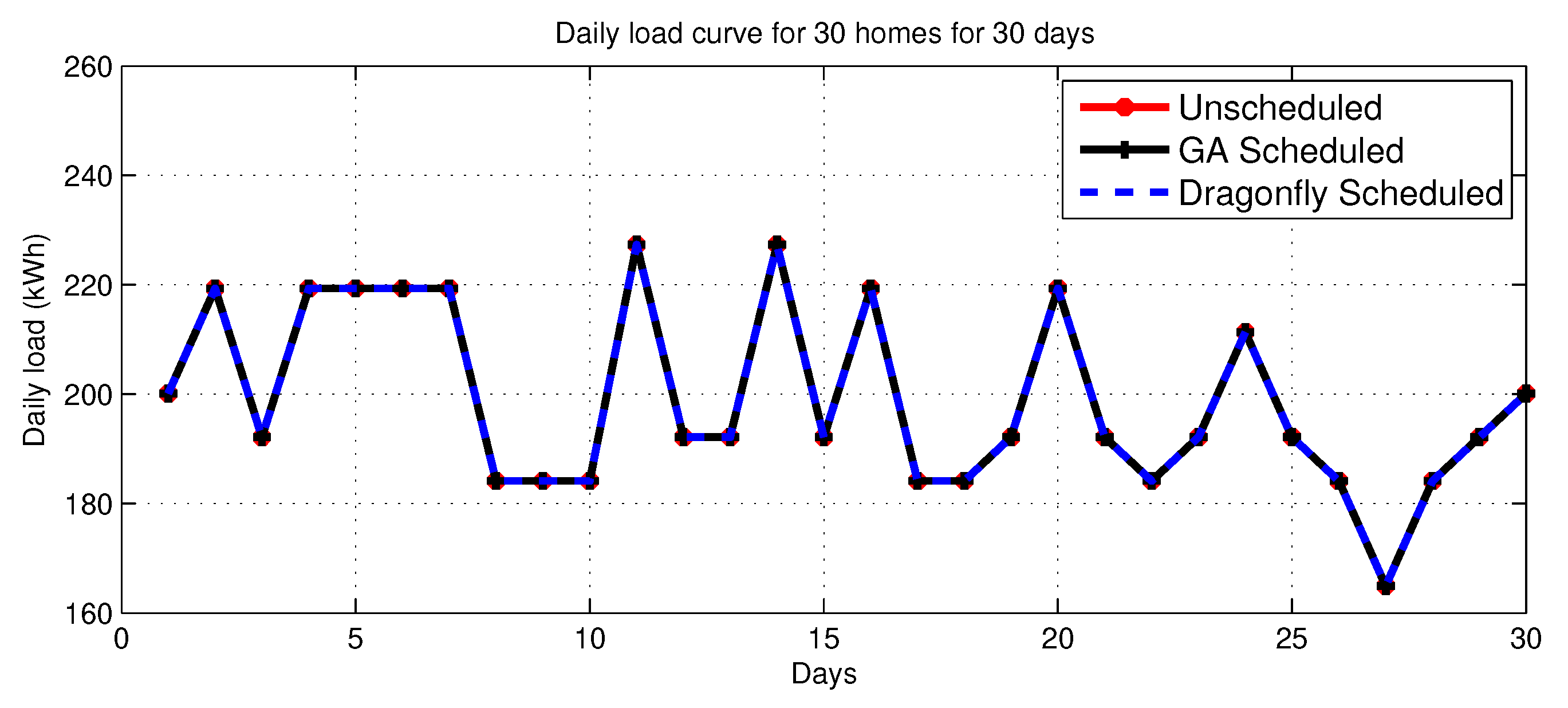


| Appliances Class | Appliance Name | Power Rating (kW) | Starting Time (h) | Finishing Time (h) | LOT (h) |
|---|---|---|---|---|---|
| Coffee maker | 1.0 | 08 | 10 | 1 | |
| Printer | 0.5 | 18 | 20 | 1 | |
| Microwave oven | 1.7 | 08 | 10 | 1 | |
| Laptop | 0.1 | 18 | 24 | 2 | |
| Shiftable | Desktop | 0.3 | 18 | 24 | 3 |
| Appliances | Vacuum Cleaner | 1.2 | 09 | 17 | 1 |
| Electric Car | 3.5 | 18 | 08 | 3 | |
| Iron | 0.8 | 09 | 17 | 2 | |
| Washing Machine | 1.5 | 09 | 12 | 2 | |
| Hair Dryer | 1.5 | 13 | 18 | 1 | |
| Non-Shiftable | Interior Lightening | 0.84 | 18 | 24 | 6 |
| Appliances | Refrigerator | 0.3 | 8 | 8 | 24 |
| Techniques | No. of Homes | No. of Days | Cost ($) | % Cost Reduction | Waiting Time (h) | PAR | % PAR Reduction |
|---|---|---|---|---|---|---|---|
| 1 | 1 | 2.423 | – | – | 4.62 | – | |
| Un- | 1 | 30 | 36.017 | – | – | — | – |
| Schedule | 30 | 1 | 48.142 | – | – | 3.03 | – |
| 30 | 30 | 1432.735 | – | – | — | – | |
| 1 | 1 | 1.683 | 30.54% | 3.03 | 3.56 | 22.94% | |
| GA | 1 | 30 | 31.832 | 11.61% | — | — | — |
| Scheduled | 30 | 1 | 44.982 | 06.56% | 1.82 | 2.93 | 03.30% |
| 30 | 30 | 1357.722 | 05.23% | — | — | — | |
| 1 | 1 | 1.561 | 35.57% | 2.89 | 3.76 | 18.61% | |
| DA | 1 | 30 | 27.977 | 22.32% | — | — | — |
| Scheduled | 30 | 1 | 39.851 | 17.22% | 2.29 | 2.24 | 26.07% |
| 30 | 30 | 1267.426 | 11.54% | — | — | — |
© 2020 by the authors. Licensee MDPI, Basel, Switzerland. This article is an open access article distributed under the terms and conditions of the Creative Commons Attribution (CC BY) license (http://creativecommons.org/licenses/by/4.0/).
Share and Cite
Hussain, I.; Ullah, M.; Ullah, I.; Bibi, A.; Naeem, M.; Singh, M.; Singh, D. Optimizing Energy Consumption in the Home Energy Management System via a Bio-Inspired Dragonfly Algorithm and the Genetic Algorithm. Electronics 2020, 9, 406. https://doi.org/10.3390/electronics9030406
Hussain I, Ullah M, Ullah I, Bibi A, Naeem M, Singh M, Singh D. Optimizing Energy Consumption in the Home Energy Management System via a Bio-Inspired Dragonfly Algorithm and the Genetic Algorithm. Electronics. 2020; 9(3):406. https://doi.org/10.3390/electronics9030406
Chicago/Turabian StyleHussain, Irshad, Majid Ullah, Ibrar Ullah, Asima Bibi, Muhammad Naeem, Madhusudan Singh, and Dhananjay Singh. 2020. "Optimizing Energy Consumption in the Home Energy Management System via a Bio-Inspired Dragonfly Algorithm and the Genetic Algorithm" Electronics 9, no. 3: 406. https://doi.org/10.3390/electronics9030406
APA StyleHussain, I., Ullah, M., Ullah, I., Bibi, A., Naeem, M., Singh, M., & Singh, D. (2020). Optimizing Energy Consumption in the Home Energy Management System via a Bio-Inspired Dragonfly Algorithm and the Genetic Algorithm. Electronics, 9(3), 406. https://doi.org/10.3390/electronics9030406









